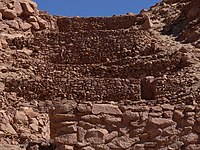
Back بوكارا Arabic Пукара Bulgarian Pucará (fortificació) Catalan Pucará (Festung) German Pucará (fortificación) Spanish Pucará French פוקרה (אינקה) HE Pucará (fortezza) Italian Пукара Russian Пукара Ukrainian


Pukara (Aymara and Quechuan "fortress", Hispanicized spellings pucara, pucará[1]) is a defensive hilltop site or fortification built by the prehispanic and historic inhabitants of the central Andean area (from Ecuador to central Chile and northwestern Argentina). In some cases, these sites acted as temporary fortified refuges during periods of increased conflict, while other sites show evidence for permanent occupation.[2] Emerging as a major site type during the Late Intermediate Period (c. 1000-1430AD), the pukara form was adopted in some areas by the Inca military in contested borderlands of the Inca Empire. The Spanish also referred to the Mapuche earthen forts built during the Arauco War in the 16th and 17th centuries by this term.
Today, the term is commonly found in toponyms of the Andes region, e.g. Andalicán, Pucará de Angol, Camiña, Cañete[verification needed], Nama, Quiapo, Tilcara, Turi, Pucara del Cerro La Muralla, Pukara of La Compañía, Pukara de Lasana, Pucará de Belén, Pukará de Quitor and Puka Pukara.
The Argentine Pucará ground attack aircraft is named after the fortresses.
- ^ "pucará". «Diccionario de la lengua española» - Edición del Tricentenario (in Spanish). 2022.
- ^ Álvarez Larrain, Alina; Greco, Catriel, eds. (26 April 2018). Political landscapes of the late intermediate period in the southern Andes : the pukaras and their hinterlands. Springer. ISBN 978-3319767284. OCLC 1022085192.